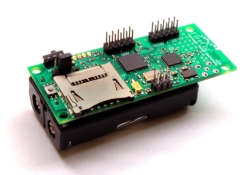Page History: Technologies & Tools @CISTER/IPP-HURRAY
Compare Page Revisions
Page Revision: 2007/06/19 14:06
§§§EditSectionPlaceHolder§§§WSN Platforms
§§§EditSectionPlaceHolder§§§Overview
Our WSNs Lab (picture at right) is equipped with several WSN mote, sensor, data acquisition and interface boards.
We have around 200 mote platforms, from different manufacturers, namely:
- 75 MICAz motes (IEEE 802.15.4-compliant), from CrossBow
- 50 TelosB motes (IEEE 802.15.4-compliant), from CrossBow
- 5 motes (IEEE 802.15.4-compliant), from ATMEL
- 5 motes, from ScatterWeb
- 10 FireFly motes, from CMU
The picture below depicts some examples of available WSN technology (from CrossBow):
From top to bottom, left to right: TelosB mote, MICAz mote with housing, MICAz mote, data acquisition board, sensor board, Stargate Single Board Computer and three interface boards for interacting (programming, monitoring) with the motes: USB, Ethernet and RS-232.
§§§EditSectionPlaceHolder§§§MICAz
The MICAz is a 2.4 GHz, IEEE/ZigBee 802.15.4, board used for low-power, wireless, sensor networks. It uses an Atmel ATmega1281 8-bit micro-controller with 8KB of RAM and 128KB of ROM along with Chipcon’s CC2420 IEEE 802.15.4 standard-compliant radio transceiver for communication. The maximum packet size supported by 802.15.4 is 128 bytes and the maximum raw data rate is 250Kbps. It also has
several sensor boards providing light, temperature, audio, among other sensors.
§§§EditSectionPlaceHolder§§§FireFly

The FireFly Sensor Networking Platform is a low-cost low-power hardware platform. In order to better support real-time applications, the system is built around maintaining global time synchronization. The main Firefly board uses an Atmel ATmega1281 8-bit micro-controller with 8KB of RAM and 128KB of ROM along with Chipcon’s CC2420 IEEE 802.15.4 standard-compliant radio transceiver for communication. The maximum packet size supported by 802.15.4 is 128 bytes and the maximum raw data rate is 250Kbps. The FireFly board supports various external peripherals such as a sensor expansion card, high voltage power monitoring and control board, and a firefly-hardware-clock-sync hardware clock synchronization module. The sensor expansion card provides light, temperature, audio, passive infrared motion, dual axis acceleration and voltage sensing. The high voltage power monitoring and control board allows for sensing of current draw as well as on/off actuation of 120VAC appliances. The base FireFly platform provides an SDIO port which can be used for large FLASH storage or as a universal interface to PC compatible peripherals. The FireFly platform includes a downloading and code execution time profiling board for easy development.
§§§EditSectionPlaceHolder§§§TelosB
The TelosB is a 2.4 GHz, IEEE/ZigBee 802.15.4, board used for low-power, wireless, sensor networks. It has USB programming capability, Chipcon’s CC2420 IEEE 802.15.4 standard-compliant radio transceiver for communication with integrated antenna, a low-power microcontroller (TI-MSP430) from Texas Instruments with extended memory and several onboard sensors.
§§§EditSectionPlaceHolder§§§Analysers
Concerning IEEE 802.15.4/ZigBee protocols, we use two different network/protocol analyser applications (sniffers):
- CC2420 Packet Sniffer for IEEE 802.15.4 v1.0 (Chipcon)
- IEEE 802.15.4/ZigBee Network/Protocol Analyser (Daintree)
The first is quite adequate for providing a raw list of the packets transmitted. The (freeware) application works in conjunction with a CC2400EB evaluation board and a CC2420 radio transceiver. The second provides a more complete set of functionalities, namely graphical topology of the network, statistics, message flows, PAN information, association details, etc. The picture at right presents the required hardware for the Chipcon (top) and DainTree (bottom) sniffers.
The two pictures below depict two application snapshots, one of the Chipcon (left) and another from the DainTree (right) sniffers:
§§§EditSectionPlaceHolder§§§Developed Tools & Software
§§§EditSectionPlaceHolder§§§Open-ZB Toolset
We have developed the
Open-ZB toolset to implement, test and evaluate the current functionalities defined in the IEEE 802.15.4/ZigBee standards, as well as new add-ons to these protocols. In this context, we have developed:
- an implementation of the IEEE 802.15.4/ZigBee protocol stack under nesC/TinyOS for the MICAz and TelosB motes;
- a simulation model of the IEEE 802.15.4 protocol using the OPNET Simulation Tool
The pictures below outline the software architecture of the IEEE 802.15.4/ZigBee protocol stack implementation.
The figure below outlines the software architecture of IEEE 802.15.4 OPNET simulation model:
§§§EditSectionPlaceHolder§§§nano-RK implementation of WiDOM
Implementation of the dominance protocol compatible with two embedded computer platforms: MicaZ and Firefly. MicaZ and Firefly are a sensor network platform, offering a low power microcontroller, 128 kbytes of program flash memory and an IEEE 802.15.4 compliant radio transceiver CC2420, capable of 250 kbps data rate. Both platforms are supported by nano-RK, an open-source operating system designed for wireless sensor networks.
To be available.§§§EditSectionPlaceHolder§§§TinyOS implementation of WiDOM
Implementation of the dominance protocol on an embedded computer platform known as MicaZ. MicaZ is a sensor network platform, offering a low power microcontroller, 128 kbytes of program flash memory and an IEEE 802.15.4 compliant radio transceiver CC2420, capable of 250 kbps data rate. The MicaZ platform is supported by TinyOS, an open-source operating system designed for wireless sensor networks.
After downloading the zip file, extract it and folow instructions in the README.txt file.
[
Download]
§§§EditSectionPlaceHolder§§§OMNeT++ Simulation of WiDom-MBD
Simulation model of WiDom for Multiple Broadcast Domains (MBD) in the OMNet++ simulator.
[
Download]
§§§EditSectionPlaceHolder§§§Hands-On Lab